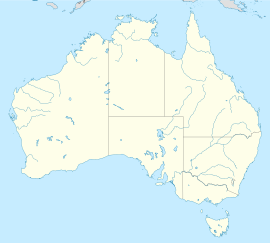Perth
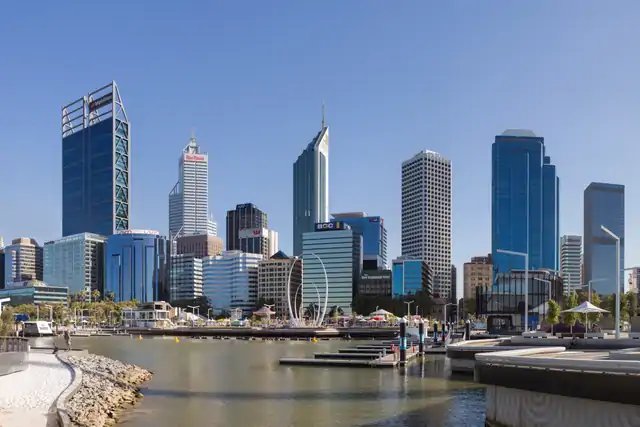
Perth

| Perth Western Australia | |||||||||
|---|---|---|---|---|---|---|---|---|---|
| Coordinates | 31°57′8″S 115°51′32″E [176] | ||||||||
| Population | 2,059,484 (2018)[6] (4th) | ||||||||
| • Density | 320.8969/km2(831.119/sq mi) | ||||||||
| Established | 1829 | ||||||||
| Area | 6,417.9 km2(2,478.0 sq mi)(GCCSA)[7] | ||||||||
| Time zone | AWST (UTC+08:00) | ||||||||
| Location | |||||||||
| State electorate(s) | Perth (and 41 others)[12] | ||||||||
| Federal Division(s) | Perth (and 10 others) | ||||||||
| |||||||||
| Country of Birth (2016)[72] | |||||||||
| Birthplace[1] | Population | ||||||||
| Australia | 1,113,290 | ||||||||
| England | 166,965 | ||||||||
| New Zealand | 61,326 | ||||||||
| India | 46,667 | ||||||||
| South Africa | 35,262 | ||||||||
| Malaysia | 28,224 | ||||||||
| Mainland China | 25,911 | ||||||||
| Philippines | 24,624 | ||||||||
| Italy | 17,461 | ||||||||
| Ireland | 16,115 | ||||||||
| Vietnam | 15,131 | ||||||||
| Singapore | 14,465 | ||||||||
| Indonesia | 10,569 | ||||||||
Perth (/ˈpɜːrθ/ (listen) PURTH) is the capital and largest city of the Australian state of Western Australia (WA). It is named after the city of Perth, Scotland and is the fourth-most populous city in Australia, with a population of 2.06 million living in Greater Perth.[6] Perth is part of the South West Land Division of Western Australia, with the majority of the metropolitan area located on the Swan Coastal Plain, a narrow strip between the Indian Ocean and the Darling Scarp. The first areas settled were on the Swan River at Guildford, with the city's central business district and port (Fremantle) both later founded downriver.
Perth was founded by Captain James Stirling in 1829 as the administrative centre of the Swan River Colony. It gained city status (currently vested in the smaller City of Perth) in 1856 and was promoted to the status of a Lord Mayorality in 1929.[13] The city inherited its name due to the influence of Sir George Murray, then Member of Parliament for Perthshire and Secretary of State for War and the Colonies. The city's population increased substantially as a result of the Western Australian gold rushes in the late 19th century. During Australia's involvement in World War II, Fremantle served as a base for submarines operating in the Pacific Theatre, and a US Navy Catalina flying boat fleet was based at Matilda Bay.[14] An influx of immigrants after the war, predominantly from Britain, Greece, Italy, and Yugoslavia, led to rapid population growth. This was followed by a surge in economic activity flowing from several mining booms in the late 20th and early 21st centuries that saw Perth become the regional headquarters for several large mining operations located around the state.
As part of Perth's role as the capital of Western Australia, the state's Parliament and Supreme Court are located within the city, as is Government House, the residence of the Governor of Western Australia. Perth came seventh in the Economist Intelligence Unit's August 2016 list of the world's most liveable cities[15] and was classified by the Globalization and World Cities Research Network in 2010 as a Beta world city.[16] The city hosted the 1962 Commonwealth Games.
Perth is divided into 30 local government areas and 250 suburbs, stretching from Two Rocks in the north to Singleton in the south, and east inland to The Lakes. Outside of the main CBD, important urban centres within Perth include Fremantle and Joondalup. Most of those were originally established as separate settlements and retained a distinct identity after being subsumed into the wider metropolitan area. Mandurah, Western Australia's second-largest city, has in recent years formed a conurbation with Perth along the coast, though for most purposes it is still considered a separate city.
| Perth Western Australia | |||||||||
|---|---|---|---|---|---|---|---|---|---|
| Coordinates | 31°57′8″S 115°51′32″E [176] | ||||||||
| Population | 2,059,484 (2018)[6] (4th) | ||||||||
| • Density | 320.8969/km2(831.119/sq mi) | ||||||||
| Established | 1829 | ||||||||
| Area | 6,417.9 km2(2,478.0 sq mi)(GCCSA)[7] | ||||||||
| Time zone | AWST (UTC+08:00) | ||||||||
| Location | |||||||||
| State electorate(s) | Perth (and 41 others)[12] | ||||||||
| Federal Division(s) | Perth (and 10 others) | ||||||||
| |||||||||
| Country of Birth (2016)[72] | |||||||||
| Birthplace[1] | Population | ||||||||
| Australia | 1,113,290 | ||||||||
| England | 166,965 | ||||||||
| New Zealand | 61,326 | ||||||||
| India | 46,667 | ||||||||
| South Africa | 35,262 | ||||||||
| Malaysia | 28,224 | ||||||||
| Mainland China | 25,911 | ||||||||
| Philippines | 24,624 | ||||||||
| Italy | 17,461 | ||||||||
| Ireland | 16,115 | ||||||||
| Vietnam | 15,131 | ||||||||
| Singapore | 14,465 | ||||||||
| Indonesia | 10,569 | ||||||||
History

The area of Perth contains the Whadjuk people, who are one of several groups in south-western Western Australia which make up the Noongar people.
Indigenous Australians have inhabited the Perth area for at least 38,000 years, as evidenced by archaeological remains at Upper Swan. The Noongar people occupied the southwest corner of Western Australia and lived as hunter-gatherers. The wetlands on the Swan Coastal Plain were particularly important to them, both spiritually (featuring in local mythology) and as a source of food.[17]
The Noongar people know the area where Perth now stands as Boorloo. Boorloo formed part of the territory of the Mooro, a Noongar clan, which at the time of British settlement had Yellagonga as their leader. The Mooro was one of several Noongar Indigenous clans based around the Swan River known collectively as the Whadjuk. The Whadjuk themselves were one of a larger group of fourteen tribes that formed the south-west socio-linguistic block known as the Noongar (meaning "the people" in their language), also sometimes called the Bibbulmun.[18] On 19 September 2006, the Federal Court of Australia brought down a judgment recognising Noongar native title over the Perth metropolitan area in the case of Bennell v State of Western Australia [2006] FCA 1243.[19] The judgment was overturned on appeal.[20]
Early European sightings
The first documented sighting of the region was made by the Dutch Captain Willem de Vlamingh and his crew on 10 January 1697.[21] Subsequent sightings between this date and 1829 were made by other Europeans, but as in the case of the sighting and observations made by Vlamingh, the area was considered to be inhospitable and unsuitable for the agriculture that would be needed to sustain a settlement.[22]
Swan River Colony
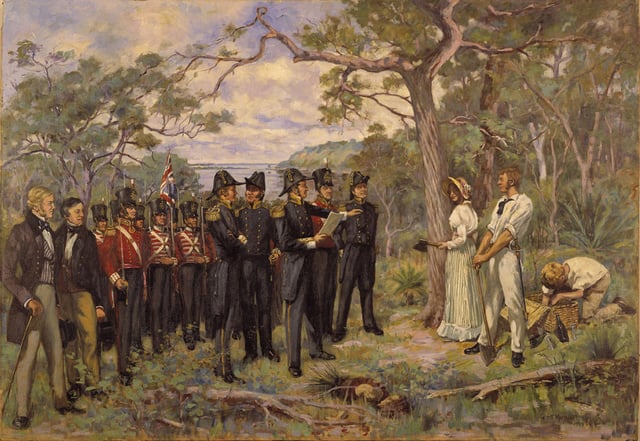
The Foundation of Perth 1829 by George Pitt Morison is a historically accurate reconstruction of the official ceremony by which Perth was founded.
Although the Colony of New South Wales had established a convict-supported settlement at King George's Sound (later Albany) on the south coast of Western Australia in 1826 in response to rumours that the area would be annexed by France, Perth was the first full-scale settlement by Europeans in the western third of the continent. The British colony would be officially designated Western Australia in 1832 but was known informally for many years as the Swan River Colony after the area's major watercourse.[23]
On 4 June 1829, newly arriving British colonists had their first view of the mainland, and Western Australia's founding has since been recognised by a public holiday on the first Monday in June each year. Captain James Stirling, aboard Parmelia, said that Perth was "as beautiful as anything of this kind I had ever witnessed". On 12 August that year, Helen Dance, wife of the captain of the second ship, Sulphur, cut down a tree to mark the founding of the town.
It is clear that Stirling had already selected the name Perth for the capital well before the town was proclaimed, as his proclamation of the colony, read in Fremantle on 18 June 1829, ended "given under my hand and Seal at Perth this 18th Day of June 1829. James Stirling Lieutenant Governor".[24] The only contemporary information on the source of the name comes from Fremantle's diary entry for 12 August, which records that they "named the town Perth according to the wishes of Sir George Murray".[25] Murray was born in Perth, Scotland, and was in 1829 Secretary of State for the Colonies and Member for Perthshire in the British House of Commons. The town was named after the Scottish Perth,[26] in Murray's honour.[27][28][29] Beginning in 1831, hostile encounters between the British settlers and the Noongar people – both large-scale land users, with conflicting land value systems – increased considerably as the colony grew. The hostile encounters between the two groups of people resulted in multiple events, including the execution of the Whadjuk elder Midgegooroo, the death of his son Yagan in 1833, and the Pinjarra massacre in 1834. The relations between the Noongar people and the Europeans were strained due to these events. Because of the large number of buildings in and around Boorloo, the local Whadjuk Noongar people were slowly dispossessed of their country. They were forced to camp around prescribed areas, including the swamps and lakes north of the settlement area including Third Swamp, known to them as Boodjamooling. Boodjamooling continued to be a main campsite for the remaining Noongar people in the Perth region and was also used by travellers, itinerants, and homeless people. By the gold-rush days of the 1890s, they were joined by miners who were en route to the goldfields.[30]
Convict era and gold rushes
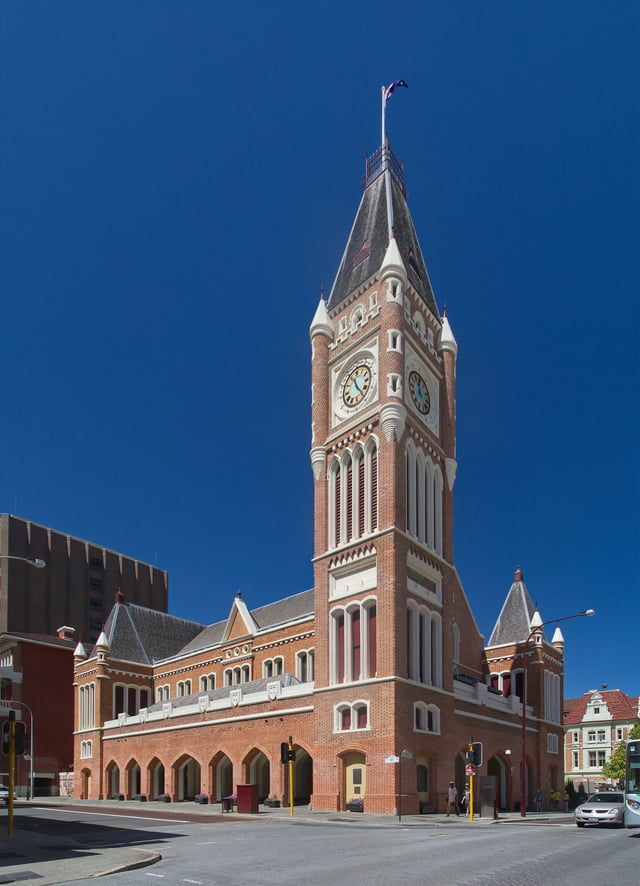
Perth Town Hall, like many colonial buildings in Perth, was built using convict labour.
In 1850, Western Australia was opened to convicts at the request of farming and business people looking for cheap labour.[31] Queen Victoria announced the city status of Perth in 1856.[32] Despite this proclamation, Perth was still a quiet town, described in 1870 by a Melbourne journalist as:
"...a quiet little town of some 3000 inhabitants spread out in straggling allotments down to the water's edge, intermingled with gardens and shrubberies and half rural in its aspect ... The main streets are macadamised, but the outlying ones and most of the footpaths retain their native state from the loose sand — the all pervading element of Western Australia — productive of intense glare or much dust in the summer and dissolving into slush during the rainy season."[33]
Federation and beyond
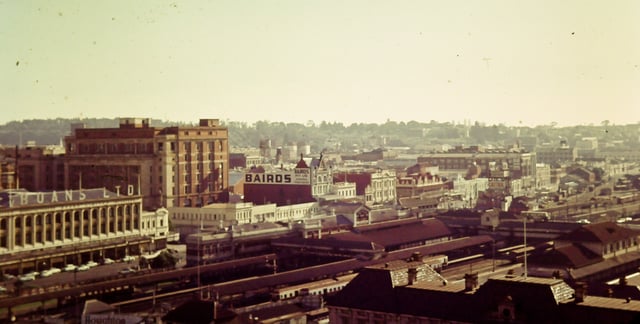
Perth looking across the Perth train station c. 1955
After a referendum in 1900,[36] Western Australia joined the Federation of Australia in 1901.[32] It was the last of the Australian colonies to agree to join the Federation, and did so only after the other colonies had offered several concessions, including the construction of a transcontinental railway line from Port Augusta in South Australia to Kalgoorlie to link Perth with the eastern states.[37]
In 1933, Western Australia voted in a referendum to leave the Australian Federation, with a majority of two to one in favour of secession. However, the state general election held at the same time as the referendum had voted out the incumbent "pro-independence" government, replacing it with a government that did not support the independence movement. Respecting the result of the referendum, the new government nonetheless petitioned the Imperial Parliament at Westminster. The House of Commons established a select committee to consider the issue but after 18 months of negotiations and lobbying, finally refused to consider the matter, declaring that it could not legally grant secession.[36][38]
In 1962, Perth received global media attention when city residents lit their house lights and streetlights as American astronaut John Glenn passed overhead while orbiting the earth on Friendship 7. This led to it being nicknamed the "City of Light".[39][40][41] The city repeated the act as Glenn passed overhead on the Space Shuttle in 1998.[42][43]
Perth's development and relative prosperity, especially since the mid-1960s,[44] has resulted from its role as the main service centre for the state's resource industries, which extract gold, iron ore, nickel, alumina, diamonds, mineral sands, coal, oil, and natural gas.[45] Whilst most mineral and petroleum production takes place elsewhere in the state, the non-base services provide most of the employment and income to the people of Perth.[46]
Geography
Central business district

Perth skyline from Kings Park, 2012
The central business district of Perth is bounded by the Swan River to the south and east, with Kings Park on the western end, while the railway reserve formed a northern border. A state and federally funded project named Perth City Link sunk a section of the railway line, to allow easy pedestrian access between Northbridge and the CBD. The Perth Arena is a building in the city link area that has received several architecture awards from various institutions such as the Design Institute of Australia, the Australian Institute of Architecture, and Colorbond.[47] St Georges Terrace is the prominent street of the area with 1.3 million m2 of office space in the CBD.[48] Hay Street and Murray Street have most of the retail and entertainment facilities. The tallest building in the city is Central Park, which is the eighth tallest building in Australia.[49] The CBD until 2012 was the centre of a mining-induced boom, with several commercial and residential projects being built, including Brookfield Place, a 244 m (801 ft) office building for Anglo-Australian mining company BHP Billiton.[50]
Geology and landforms
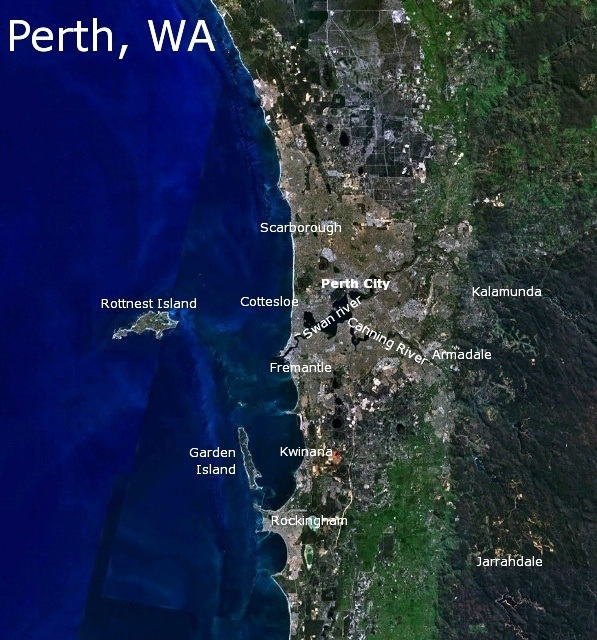
Satellite image of Perth
Perth is set on the Swan River, named for the native black swans by Willem de Vlamingh, captain of a Dutch expedition and namer of WA's Rottnest Island who discovered the birds while exploring the area in 1697.[51] Traditionally, this water body had been known by Aboriginal inhabitants as Derbarl Yerrigan.[52] The city centre and most of the suburbs are located on the sandy and relatively flat Swan Coastal Plain, which lies between the Darling Scarp and the Indian Ocean. The soils of this area are quite infertile. The metropolitan area extends along the coast to Two Rocks in the north and Singleton to the south,[53] a total distance of approximately 125 kilometres (78 mi).[54] From the coast in the west to Mundaring in the east is a total distance of approximately 50 km (31 mi). The Perth metropolitan area covers 6,418 km2 (2,478 sq mi).[7]
Much of Perth was built on the Perth Wetlands, a series of freshwater wetlands running from Herdsman Lake in the west through to Claisebrook Cove in the east.[55]
To the east, the city is bordered by a low escarpment called the Darling Scarp. Perth is on generally flat, rolling land – largely due to the high amount of sandy soils and deep bedrock. The Perth metropolitan area has two major river systems: the first is made up of the Swan and Canning Rivers; the second is that of the Serpentine and Murray Rivers, which discharge into the Peel Inlet at Mandurah.
Climate
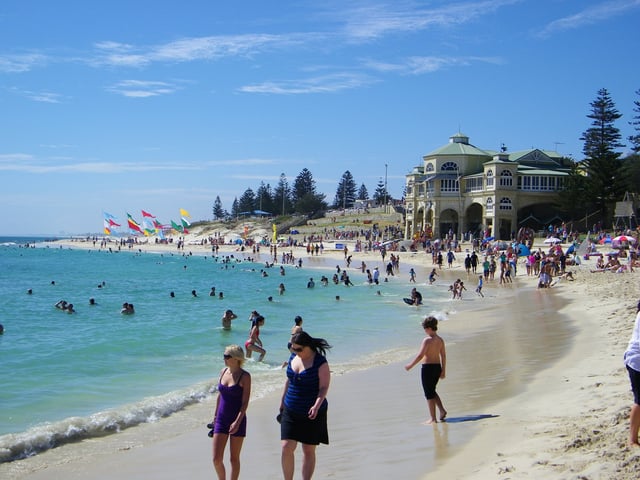
Cottesloe Beach
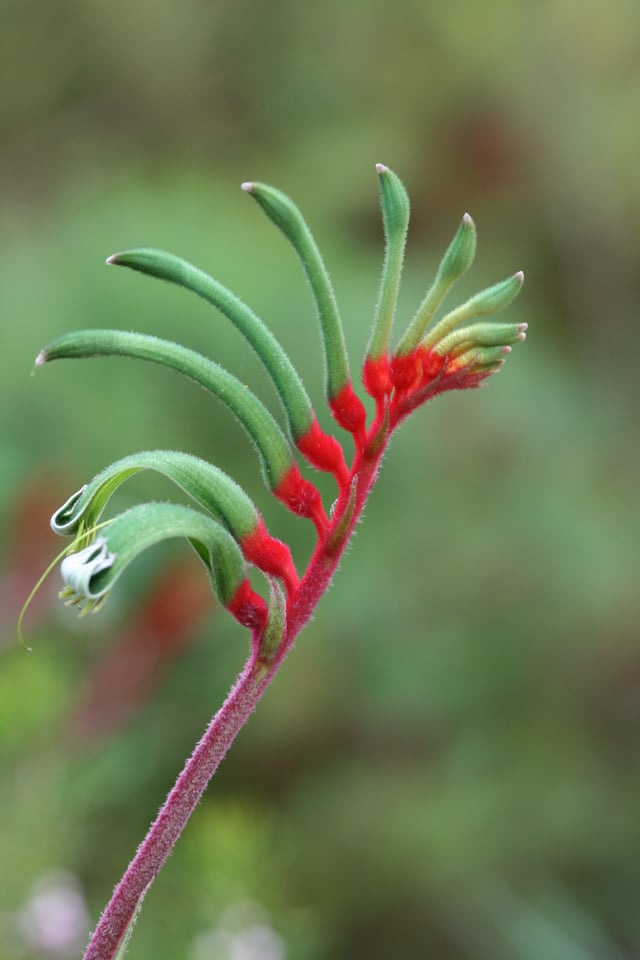
Kangaroo Paw at Kings Park
Perth receives moderate though highly seasonal, winter based rainfall. Summers are generally hot and dry, lasting from December to March, with February generally being the hottest month of the year. Winters are cool and wet, giving Perth a hot-summer Mediterranean climate (Köppen climate classification Csa).[56][57] Perth has an average of 8.8 hours of sunshine per day, which equates to around 3200 hours of annual sunshine, and 138.7 clear days annually, making it the sunniest capital city in Australia.[58]
Summers are dry but not completely devoid of rain, with sporadic rainfall in the form of short-lived thunderstorms, cold fronts and on occasions decaying tropical cyclones from Western Australia's north-west, which can bring heavy rain. Winters see significant rainfall as frontal systems move across the region, interspersed with clear and sunny days. The highest temperature recorded in Perth was 46.2 °C (115.2 °F) on 23 February 1991, although Perth Airport recorded 46.7 °C (116.1 °F) on the same day.[58][59] On most summer afternoons a sea breeze, known locally as the "Fremantle Doctor", blows from the southwest, providing relief from the hot north-easterly winds. Temperatures often fall below 30 °C (86 °F) a few hours after the arrival of the wind change.[60] In the summer, the 3 pm dewpoint averages at around 12 °C (54 °F).[58]
Winters are wet but mild, with most of Perth's annual rainfall being between May and September. The lowest temperature recorded in Perth was −0.7 °C (30.7 °F) on 17 June 2006.[59] The lowest temperature within the Perth metropolitan area was −3.4 °C (25.9 °F) on the same day at Jandakot Airport. However, temperatures at or below zero are very rare occurrences. It occasionally gets cold enough for frost to form.[61] While snow has never been recorded in the Perth CBD, light snowfalls have been reported in outer suburbs of Perth in the Perth Hills around Kalamunda, Roleystone and Mundaring. The most recent snowfall was in 1968.
The rainfall pattern has changed in Perth and southwest Western Australia since the mid-1970s. A significant reduction in winter rainfall has been observed with a greater number of extreme rainfall events in the summer months,[62] such as the slow-moving storms on 8 February 1992 that brought 120.6 millimetres (4.75 in) of rain,[59][60] heavy rainfall associated with a tropical low on 10 February 2017, which brought 114.4 millimetres (4.50 in) of rain,[63] and the remnants of ex-Tropical Cyclone Joyce on 15 January 2018 with 96.2 millimetres (3.79 in).[64] Perth was also impacted by a severe thunderstorm on 22 March 2010, which brought 40.2 mm (1.58 in) of rain and large hail and caused significant damage in the metropolitan area.[65]
The average temperature of the sea ranges from 18.9 °C (66.0 °F) in October to 23.4 °C (74.1 °F) in March.[66]
| Climate data for Perth, Western Australia | |||||||||||||
|---|---|---|---|---|---|---|---|---|---|---|---|---|---|
| Month | Jan | Feb | Mar | Apr | May | Jun | Jul | Aug | Sep | Oct | Nov | Dec | Year |
| Average high °C (°F) | 31.2 (88.2) | 31.6 (88.9) | 29.6 (85.3) | 25.9 (78.6) | 22.3 (72.1) | 19.4 (66.9) | 18.4 (65.1) | 19.0 (66.2) | 20.3 (68.5) | 23.4 (74.1) | 26.7 (80.1) | 29.1 (84.4) | 24.7 (76.5) |
| Daily mean °C (°F) | 24.6 (76.3) | 24.9 (76.8) | 23.1 (73.6) | 19.8 (67.6) | 16.4 (61.5) | 13.9 (57.0) | 13.1 (55.6) | 13.6 (56.5) | 14.9 (58.8) | 17.5 (63.5) | 20.5 (68.9) | 22.7 (72.9) | 18.7 (65.7) |
| Average low °C (°F) | 18.1 (64.6) | 18.3 (64.9) | 16.7 (62.1) | 13.8 (56.8) | 10.5 (50.9) | 8.5 (47.3) | 7.8 (46.0) | 8.3 (46.9) | 9.5 (49.1) | 11.6 (52.9) | 14.3 (57.7) | 16.3 (61.3) | 12.8 (55.0) |
| Average rainfall mm (inches) | 20.2 (0.80) | 13.1 (0.52) | 19.7 (0.78) | 35.7 (1.41) | 89.4 (3.52) | 124.5 (4.90) | 145.9 (5.74) | 126.0 (4.96) | 84.8 (3.34) | 38.8 (1.53) | 21.8 (0.86) | 10.9 (0.43) | 733.2 (28.87) |
| Average precipitation days | 2.9 | 2.2 | 4.5 | 6.8 | 11.3 | 14.3 | 17.3 | 16.0 | 14.9 | 9.2 | 5.6 | 3.5 | 108.5 |
| Average afternoon relative humidity (%) | 39 | 38 | 40 | 46 | 50 | 56 | 57 | 54 | 53 | 47 | 44 | 41 | 47 |
| Mean daily sunshine hours | 11.5 | 11.0 | 9.6 | 8.3 | 6.9 | 5.9 | 6.1 | 7.2 | 7.7 | 9.6 | 10.6 | 11.5 | 8.8 |
| Source: Bureau of Meteorology[67] | |||||||||||||
Isolation
Perth is one of the most isolated major cities in the world. The nearest city with a population of more than 100,000 is Adelaide, over 1,300 mi (2,092 km) away.[68] Perth is geographically closer to both East Timor (1,731 mi or 2,786 km), and Jakarta, Indonesia (1,865 mi or 3,001 km), than to Sydney (2,045 mi or 3,291 km).[68]
Demographics
| Historical populations | ||||||||||||||||||||||||||||||||||||||||||||||||||||||||||||||||||||||||||||||||||||||||||
|---|---|---|---|---|---|---|---|---|---|---|---|---|---|---|---|---|---|---|---|---|---|---|---|---|---|---|---|---|---|---|---|---|---|---|---|---|---|---|---|---|---|---|---|---|---|---|---|---|---|---|---|---|---|---|---|---|---|---|---|---|---|---|---|---|---|---|---|---|---|---|---|---|---|---|---|---|---|---|---|---|---|---|---|---|---|---|---|---|---|---|
| ||||||||||||||||||||||||||||||||||||||||||||||||||||||||||||||||||||||||||||||||||||||||||
| Perth Statistical Division | ||||||||||||||||||||||||||||||||||||||||||||||||||||||||||||||||||||||||||||||||||||||||||
| Year | Pop. | ±% | ||||||||||||||||||||||||||||||||||||||||||||||||||||||||||||||||||||||||||||||||||||||||
| 1854 | 4,001 | — | ||||||||||||||||||||||||||||||||||||||||||||||||||||||||||||||||||||||||||||||||||||||||
| 1859 | 6,293 | +57.3% | ||||||||||||||||||||||||||||||||||||||||||||||||||||||||||||||||||||||||||||||||||||||||
| 1870 | 8,220 | +30.6% | ||||||||||||||||||||||||||||||||||||||||||||||||||||||||||||||||||||||||||||||||||||||||
| 1881 | 9,955 | +21.1% | ||||||||||||||||||||||||||||||||||||||||||||||||||||||||||||||||||||||||||||||||||||||||
| 1891 | 16,694 | +67.7% | ||||||||||||||||||||||||||||||||||||||||||||||||||||||||||||||||||||||||||||||||||||||||
| 1901 | 67,431 | +303.9% | ||||||||||||||||||||||||||||||||||||||||||||||||||||||||||||||||||||||||||||||||||||||||
| 1911 | 116,181 | +72.3% | ||||||||||||||||||||||||||||||||||||||||||||||||||||||||||||||||||||||||||||||||||||||||
| 1921 | 170,213 | +46.5% | ||||||||||||||||||||||||||||||||||||||||||||||||||||||||||||||||||||||||||||||||||||||||
| 1933 | 230,340 | +35.3% | ||||||||||||||||||||||||||||||||||||||||||||||||||||||||||||||||||||||||||||||||||||||||
| 1947 | 302,968 | +31.5% | ||||||||||||||||||||||||||||||||||||||||||||||||||||||||||||||||||||||||||||||||||||||||
| 1954 | 395,049 | +30.4% | ||||||||||||||||||||||||||||||||||||||||||||||||||||||||||||||||||||||||||||||||||||||||
| 1961 | 475,398 | +20.3% | ||||||||||||||||||||||||||||||||||||||||||||||||||||||||||||||||||||||||||||||||||||||||
| 1966 | 559,298 | +17.6% | ||||||||||||||||||||||||||||||||||||||||||||||||||||||||||||||||||||||||||||||||||||||||
| 1971 | 703,199 | +25.7% | ||||||||||||||||||||||||||||||||||||||||||||||||||||||||||||||||||||||||||||||||||||||||
| Source: ABS [177] | ||||||||||||||||||||||||||||||||||||||||||||||||||||||||||||||||||||||||||||||||||||||||||
| Greater Perth Statistical Area | ||||||||||||||||||||||||||||||||||||||||||||||||||||||||||||||||||||||||||||||||||||||||||
| Year | Pop. | ±% | ||||||||||||||||||||||||||||||||||||||||||||||||||||||||||||||||||||||||||||||||||||||||
| 1971 | 744,600 | — | ||||||||||||||||||||||||||||||||||||||||||||||||||||||||||||||||||||||||||||||||||||||||
| 1976 | 845,700 | +13.6% | ||||||||||||||||||||||||||||||||||||||||||||||||||||||||||||||||||||||||||||||||||||||||
| 1981 | 941,479 | +11.3% | ||||||||||||||||||||||||||||||||||||||||||||||||||||||||||||||||||||||||||||||||||||||||
| 1986 | 1,075,959 | +14.3% | ||||||||||||||||||||||||||||||||||||||||||||||||||||||||||||||||||||||||||||||||||||||||
| 1991 | 1,226,115 | +14.0% | ||||||||||||||||||||||||||||||||||||||||||||||||||||||||||||||||||||||||||||||||||||||||
| 1996 | 1,344,378 | +9.6% | ||||||||||||||||||||||||||||||||||||||||||||||||||||||||||||||||||||||||||||||||||||||||
| 2001 | 1,452,058 | +8.0% | ||||||||||||||||||||||||||||||||||||||||||||||||||||||||||||||||||||||||||||||||||||||||
| 2006 | 1,590,007 | +9.5% | ||||||||||||||||||||||||||||||||||||||||||||||||||||||||||||||||||||||||||||||||||||||||
| 2008 | 1,687,815 | +6.2% | ||||||||||||||||||||||||||||||||||||||||||||||||||||||||||||||||||||||||||||||||||||||||
| 2010 | 1,785,076 | +5.8% | ||||||||||||||||||||||||||||||||||||||||||||||||||||||||||||||||||||||||||||||||||||||||
| Source: ABS[69] Note: Greater Perth includes the City of Mandurah and part of the Shire of Murray, south of Perth.[53][70] | ||||||||||||||||||||||||||||||||||||||||||||||||||||||||||||||||||||||||||||||||||||||||||
Ancestry and immigration
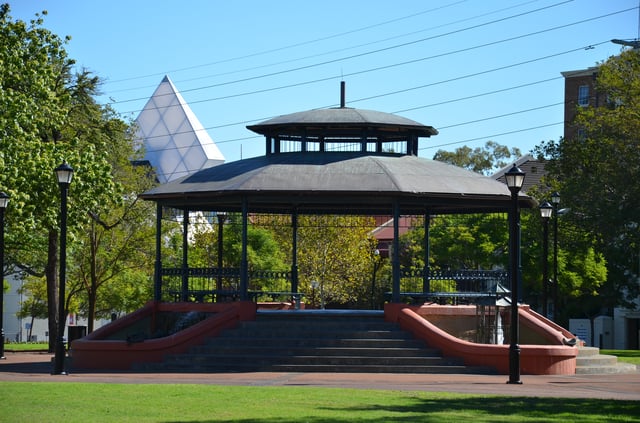
Russell Square, Northbridge - the favoured meeting place of the Italian community of "Little Italy"
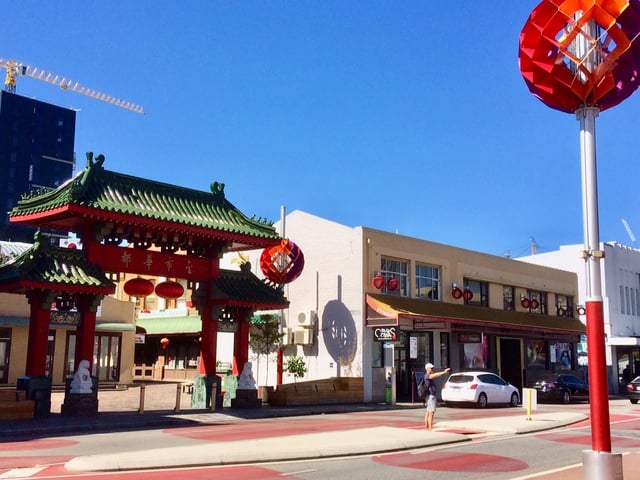
Chinatown entry on Roe Street
The ethnic make-up of Perth changed in the second part of the 20th century when significant numbers of continental European immigrants arrived in the city. Prior to this, Perth's population had been almost completely Anglo-Celtic in ethnic origin. As Fremantle was the first landfall in Australia for many migrant ships coming from Europe in the 1950s and 1960s, Perth started to experience a diverse influx of people, including Italians, Greeks, Dutch, Germans, Turks, Croats, and Macedonians. The Italian influence in the Perth and Fremantle area has been substantial, evident in places like the "Cappuccino strip" in Fremantle featuring many Italian eateries and shops. In Fremantle, the traditional Italian blessing of the fleet festival is held every year at the start of the fishing season. In Northbridge every December is the San Nicola (Saint Nicholas) Festival, which involves a pageant followed by a concert, predominantly in Italian. Suburbs surrounding the Fremantle area, such as Spearwood and Hamilton Hill, also contain high concentrations of Italians, Croatians and Portuguese. Perth has also been home to a small Jewish community since 1829[75] – numbering 5,082 in 2006 – who have emigrated primarily from Eastern Europe and more recently from South Africa.
Another more recent wave of arrivals includes the white minority from South Africa. South African residents overtook those born in Italy as the fourth largest foreign group in 2001. By 2016, there were 35,262 South Africans residing in Perth.[72] Many Afrikaners and Anglo-Africans emigrated to Perth during the 1980s and 1990s, with the phrase "packing for Perth" becoming associated with South Africans who choose to emigrate abroad, sometimes regardless of the destination.[76] As a result, the city has been described as "the Australian capital of South Africans in exile".[77] The reason for Perth's popularity among white South Africans has often been attributed to the location, the vast amount of land, and the slightly warmer climate compared to other large Australian cities – Perth has a Mediterranean climate reminiscent of Cape Town.
Since the end of the White Australia policy in 1973, Asia has become an increasingly important source of migrants, with communities from Vietnam, Malaysia, Indonesia, Thailand, Singapore, Hong Kong, Mainland China, and India all now well-established. There were 99,229 persons of Chinese descent in Perth in 2016 – 5.5% of the city's population.[72] These are supported by the Australian Eurasian Association of Western Australia,[78] which also serves a community of Portuguese-Malacca Eurasian or Kristang immigrants.[79]
Middle Eastern immigrants have a presence in Perth. They come from a variety of countries, including Saudi Arabia, Syria, Iran, Iraq, Palestine, The United Arab Emirates, Oman, Yemen, Afghanistan, and Pakistan.
Perth also has one of the largest Latin American populations in Australia, with Brazilians and Chileans being the largest Latin American groups in Perth.
The Indian community includes a substantial number of Parsees who emigrated from Bombay – Perth being the closest Australian city to India – in 2016 those with Indian ancestry accounted for 3.6% of Perth's population.[72] Perth is also home to the largest population of Anglo-Burmese in the world; many settled here following the independence of Burma in 1948 with immigration taking off after 1962. The city is now the cultural hub for Anglo-Burmese worldwide.[80] There is also a substantial Anglo-Indian population in Perth, who also settled in the city following the independence of India.
1.6% of the population, or 31,214 people, identified as Indigenous Australians (Aboriginal Australians and Torres Strait Islanders) in 2016.[5][72]
Language
Religion
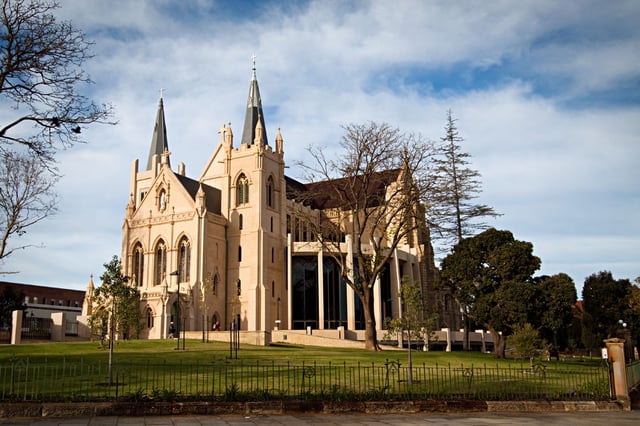
St Mary's Cathedral
Protestants, predominantly Anglican and Uniting Church, make up approximately 24% of the population.[81][82] Perth is the seat of the Anglican Diocese of Perth[83] and of the Roman Catholic Archdiocese of Perth.[84] Roman Catholics make up about 23% of the population,[81] and Catholicism is the most common single denomination.[81] The Personal Ordinariate of Our Lady of the Southern Cross claims over 2,000 members.[85]
Perth is also home to 12,000 Latter-day Saints[86] and the Perth Australia Temple of The Church of Jesus Christ of Latter-day Saints. Buddhism and Islam each claim more than 20,000 adherents.[81] Perth has the third largest Jewish population in Australia,[87] numbering approximately 20,000,[81] with both Orthodox and Progressive synagogues and a Jewish Day School.[88] The Bahá'í community in Perth numbers around 1,500.[81] Hinduism has over 20,000 adherents in Perth;[81] the Diwali (festival of lights) celebration in 2009 attracted over 20,000 visitors. There are Hindu temples in Canning Vale, Anketell and a Swaminarayan temple in Bennett Springs.[89] Hinduism is the fastest growing religion in Australia.[90]
Governance
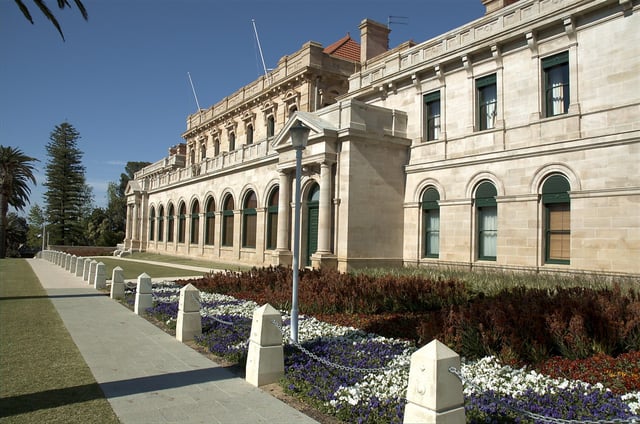
Parliament House
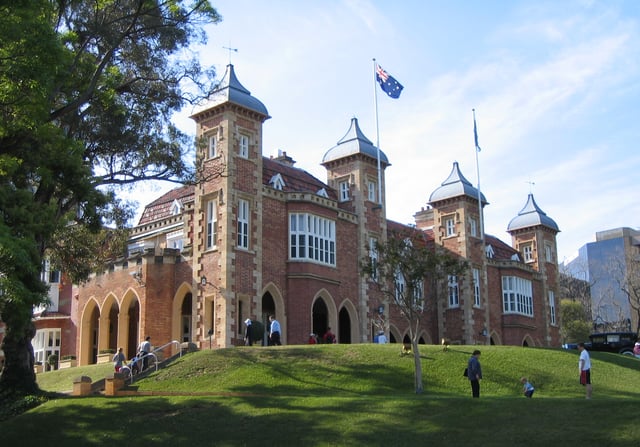
Government House
Perth houses the Parliament of Western Australia and the Governor of Western Australia. As of the 2008 state election, 42 of the Legislative Assembly's 59 seats and 18 of the Legislative Council's 36 seats are based in Perth's metropolitan area. Perth is represented by 10 full seats and significant parts of three others in the Federal House of Representatives, with the seats of Canning, Pearce and Brand including some areas outside the metropolitan area.
The metropolitan area is divided into over 30 local government bodies, including the City of Perth which administers Perth's central business district. The state's highest court, the Supreme Court, is located in Perth,[92] along with the District[93] and Family[94] Courts. The Magistrates' Court has six metropolitan locations.[95] The Federal Court of Australia and the Federal Circuit Court of Australia (previously the Federal Magistrates Court)[96][97] occupy the Commonwealth Law Courts building on Victoria Avenue,[98] which is also the location for annual Perth sittings of Australia's High Court.[99]
The administrative region of Perth includes 30 local governments, with the outer extent being the City of Wanneroo and the City of Swan to the north, the Shire of Mundaring, City of Kalamunda and the City of Armadale to the east, the Shire of Serpentine-Jarrahdale to the southeast and the City of Rockingham to the southwest, and including the islands of Rottnest Island and Garden Island off the west coast;[100] this also correlates with the Metropolitan Region Scheme.
Economy
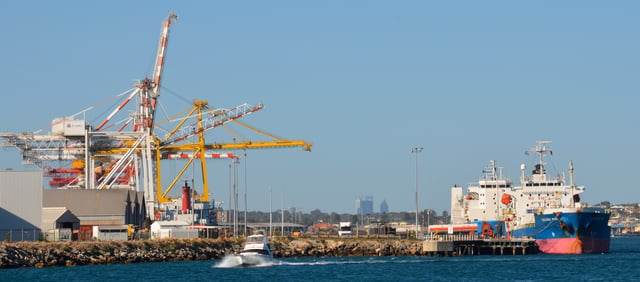
Fremantle Harbour
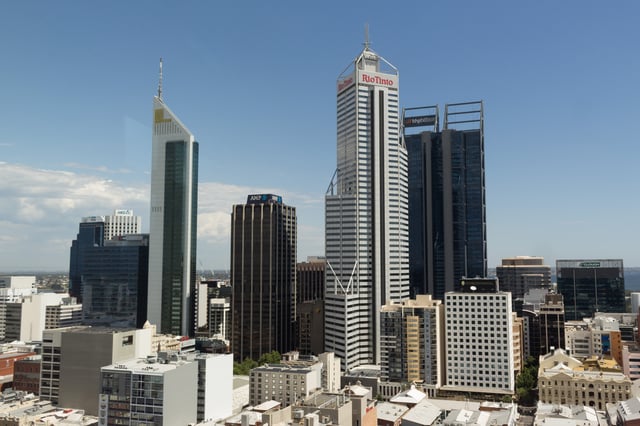
View of the Perth CBD from the north
By virtue of its population and role as the administrative centre for business and government, Perth dominates the Western Australian economy, despite the major mining, petroleum, and agricultural export industries being located elsewhere in the state.[103] Perth's function as the state's capital city, its economic base and population size have also created development opportunities for many other businesses oriented to local or more diversified markets. Perth's economy has been changing in favour of the service industries since the 1950s. Although one of the major sets of services it provides is related to the resources industry and, to a lesser extent, agriculture, most people in Perth are not connected to either; they have jobs that provide services to other people in Perth.[104]
As a result of Perth's relative geographical isolation, it has never had the necessary conditions to develop significant manufacturing industries other than those serving the immediate needs of its residents, mining, agriculture and some specialised areas, such as, in recent times, niche shipbuilding and maintenance. It was simply cheaper to import all the needed manufactured goods from either the eastern states or overseas.
Industrial employment influenced the economic geography of Perth. After WWII, Perth experienced suburban expansion aided by high levels of car ownership. Workforce decentralisation and transport improvements made it possible for the establishment of small-scale manufacturing in the suburbs. Many firms took advantage of relatively cheap land to build spacious, single-storey plants in suburban locations with plentiful parking, easy access and minimal traffic congestion. "The former close ties of manufacturing with near-central and/or rail-side locations were loosened."[103]
Industrial estates such as Kwinana, Welshpool and Kewdale were post-war additions contributing to the growth of manufacturing south of the river. The establishment of the Kwinana industrial area was supported by standardisation of the east-west rail gauge linking Perth with eastern Australia. Since the 1950s the area has been dominated by heavy industry, including an oil refinery, steel-rolling mill with a blast furnace, alumina refinery, power station and a nickel refinery. Another development, also linked with rail standardisation, was in 1968 when the Kewdale Freight Terminal was developed adjacent to the Welshpool industrial area, replacing the former Perth railway yards.[103]
With significant population growth post-WWII,[105] employment growth occurred not in manufacturing but in retail and wholesale trade, business services, health, education, community and personal services and in public administration. Increasingly it was these services sectors, concentrated around the Perth metropolitan area, that provided jobs.[103]
Education
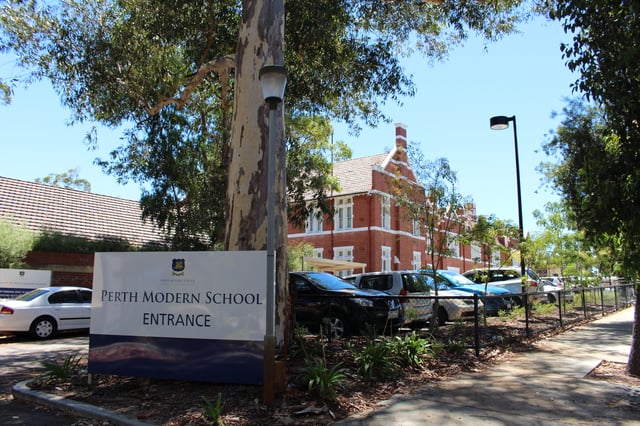
Perth Modern School, Perth's first public high school
Education is compulsory in Western Australia between the ages of six and seventeen, corresponding to primary and secondary school.[106] Tertiary education is available through several universities and technical and further education (TAFE) colleges.
Primary and secondary
Students may attend either public schools, run by the state government's Department of Education, or private schools, usually associated with a religion.
The Western Australian Certificate of Education (WACE) is the credential given to students who have completed Years 11 and 12 of their secondary schooling.[107]
In 2012 the minimum requirements for students to receive their WACE changed.[108]
Tertiary

The University of Western Australia, located in Crawley
Perth is home to four public universities: the University of Western Australia, Curtin University, Murdoch University, and Edith Cowan University. There is also one private university, the University of Notre Dame Australia.
The University of Western Australia, which was founded in 1911,[109] is renowned as one of Australia's leading research institutions.[110] The university's monumental neo-classical architecture, most of which is carved from white limestone, is a notable tourist destination in the city. It is the only university in the state to be a member of the Group of Eight, as well as the Sandstone universities. It is also the state's only university to have produced a Nobel Laureate[111] – Barry Marshall who graduated with a Bachelor of Medicine, Bachelor of Surgery in 1975 and was awarded a joint Nobel Prize in physiology or medicine in 2005, together with Robin Warren. Curtin University (previously known as Western Australian Institute of Technology (1966-1986) and Curtin University of Technology (1986-2010) is Western Australia's largest university by student population.
Murdoch University was founded in 1973 and incorporates Western Australia's only veterinary school and Australia's only theology programme to be completely integrated into a secular university.
Edith Cowan University was established in 1991 from the existing Western Australian College of Advanced Education (WACAE) which itself was formed in the 1970s from the existing Teachers Colleges at Claremont, Churchlands, and Mount Lawley. It incorporates the Western Australian Academy of Performing Arts (WAAPA).
The University of Notre Dame Australia was established in 1990. Notre Dame was established as a Catholic university with its lead campus in Fremantle and a large campus in Sydney. Its campus is set in the west end of Fremantle, using historic port buildings built in the 1890s, giving Notre Dame a distinct European university atmosphere.
Colleges of TAFE provide trade and vocational training, including certificate- and diploma-level courses. TAFE began as a system of technical colleges and schools under the Education Department, from which they were separated in the 1980s and ultimately formed into regional colleges. Two exist in the Perth metropolitan area: North Metropolitan TAFE (formerly Central Institute of Technology and West Coast Institute of Training); and South Metropolitan TAFE (formerly Polytechnic West and Challenger Institute of Technology).
Media
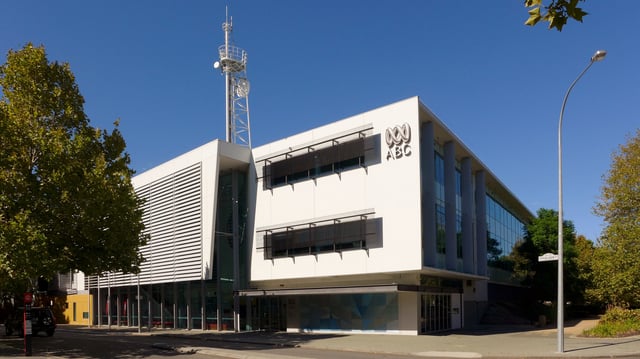
ABC Perth studios in East Perth, home of 720 ABC Perth radio and ABC television in Western Australia
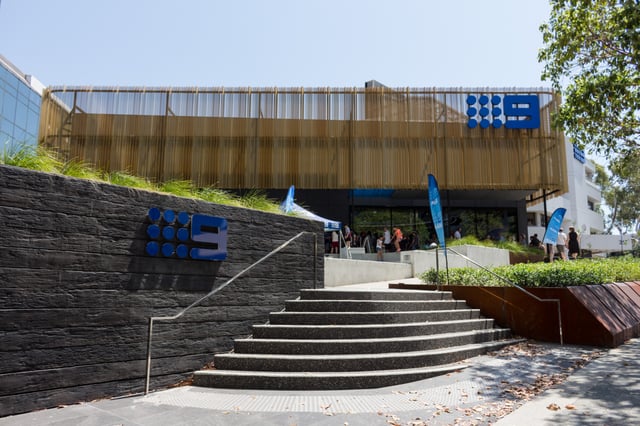
Channel 9's Perth Studio
Perth is served by thirty digital free-to-air television channels:
ABC
ABC HD (ABC broadcast in HD)
ABC Comedy/KIDS
ABC Me
ABC News
SBS
SBS HD (SBS broadcast in HD)
SBS Viceland
SBS Viceland HD (SBS Viceland broadcast in HD)
Food Network
NITV
Seven
7HD (Seven broadcast in HD)
7Two
7mate
7flix
Racing.com
Nine
9HD (Nine broadcast in HD)
9Gem
9Go!
9Life
eXtra
Ten
Ten HD (Ten broadcast in HD)
10 Bold
10 Peach
TVSN
Spree TV
West TV (Perth's community TV station)
ABC, SBS, Seven, Nine and Ten were also broadcast in an analogue format until 16 April 2013, when the analogue transmission was switched off.[112] Community station Access 31 closed in August 2008. In April 2010 a new community station, West TV, began transmission (in digital format only).
Foxtel provides a subscription-based satellite and cable television service. Perth has its own local newsreaders on ABC (James McHale), Seven (Rick Ardon, Susannah Carr), Nine (Michael Thomson) and Ten (Narelda Jacobs).
Television shows produced in Perth include local editions of the current affair program Today Tonight, and other types of programming such as The Force. An annual telethon has been broadcast since 1968 to raise funds for charities including Princess Margaret Hospital for Children. The 24-hour Perth Telethon claims to be "the most successful fundraising event per capita in the world"[113] and raised more than A$20 million in 2013, with a combined total of over A$153 million since 1968.[114]
The main newspapers for Perth are The West Australian and The Sunday Times. Localised free community papers cater for each local government area. There are also many advertising newspapers, such as The Quokka. The local business paper is Western Australian Business News.
Radio stations are on AM, FM and DAB+ frequencies. ABC stations include ABC News (585AM), 720 ABC Perth, Radio National (810AM), Classic FM (97.7FM) and Triple J (99.3FM). The six local commercial stations are Hit 92.9, Nova 93.7, Mix 94.5, 96fm, on FM and 882 6PR and 1080 6IX on AM. DAB+ has mostly the same as both FM and AM plus national stations from the ABC/SBS, Radar Radio and Novanation, along with local stations My Perth Digital, HotCountry Perth, and 98five Christian radio. Major community radio stations include RTRFM (92.1FM), Sonshine FM (98.5FM),[115] SportFM (91.3FM)[116] and Curtin FM (100.1FM).[117]
Online news media covering the Perth area include TheWest.com.au backed by The West Australian, Perth Now from the newsroom of The Sunday Times, WAToday from Fairfax Media and other outlets like TweetPerth[118] on social media.
Culture
Arts and entertainment
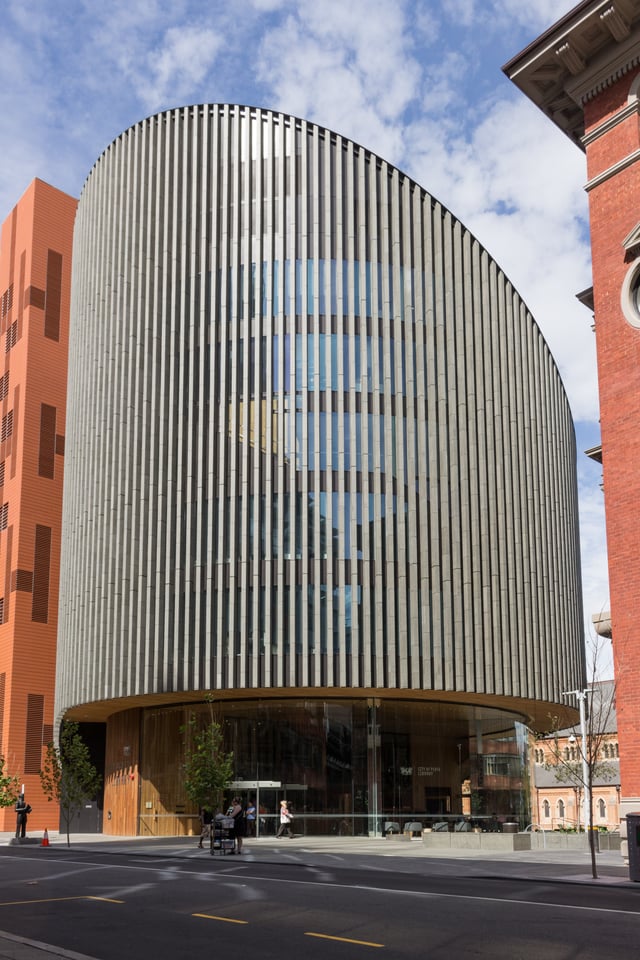
City of Perth Library
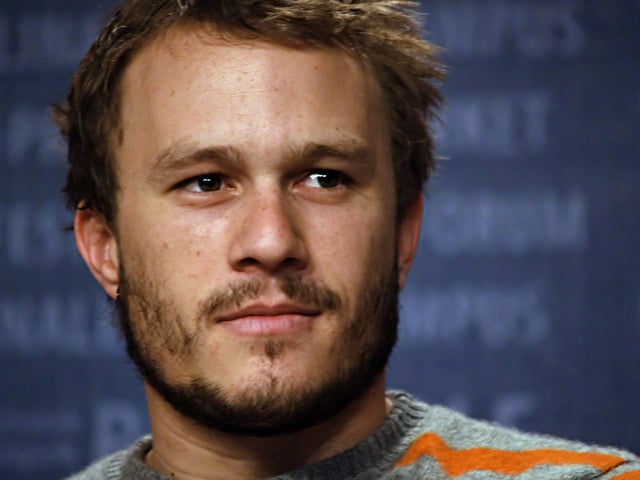
Perth actor Heath Ledger, namesake of the Heath Ledger Theatre
The Perth Cultural Centre is home to many of the city's major arts, cultural and educational institutions, including the Art Gallery of Western Australia, Western Australian Museum, State Library of Western Australia, State Records Office, and Perth Institute of Contemporary Arts (PICA).[119] The State Theatre Centre of Western Australia is also located there,[119] and is the home of the Black Swan State Theatre Company[120] and the Perth Theatre Company.[121] Other performing arts companies based in Perth include the West Australian Ballet, the West Australian Opera and the West Australian Symphony Orchestra, all of which present regular programmes.[122][123][124] The Western Australian Youth Orchestras provide young musicians with performance opportunities in orchestral and other musical ensembles.[125]
Perth is also home to the Western Australian Academy of Performing Arts at Edith Cowan University, from which many actors and broadcasters have launched their careers.[126][127] The city's main performance venues include the Riverside Theatre within the Perth Convention Exhibition Centre,[128] the Perth Concert Hall,[129] the historic His Majesty's Theatre,[130] the Regal Theatre in Subiaco[131] and the Astor Theatre in Mount Lawley.[132] The largest performance area within the State Theatre Centre, the Heath Ledger Theatre, is named in honour of Perth-born film actor Heath Ledger. Perth Arena can be configured as an entertainment or sporting arena, and concerts are also hosted at other sporting venues, including Optus Stadium, HBF Stadium, and nib Stadium. Outdoor concert venues include Quarry Amphitheatre, Supreme Court Gardens, Kings Park and Russell Square.
Perth has inspired various artistic and cultural works. John Boyle O'Reilly, a Fenian convict transported to Western Australia, published Moondyne in 1879, the most famous early novel about the Swan River Colony. Perth is also the setting for various works by novelist Tim Winton, most notably Cloudstreet (1991). Songs that refer to the city include "I Love Perth" (1996) by Pavement, "Perth" (2011) by Bon Iver, and "Perth" (2015) by Beirut. Films shot or set in Perth include Japanese Story (2003), These Final Hours (2013), Kill Me Three Times (2014) and Paper Planes (2015).
Due to Perth's relative isolation from other Australian cities, overseas performing artists sometimes exclude it from their Australian tour schedules. This isolation, however, has helped foster a strong local music scene, with many local music groups. Famous musical performers from Perth include the late AC/DC frontman Bon Scott, whose heritage-listed grave at Fremantle Cemetery is reportedly the most visited grave in Australia.[133] Perth-born performer and artist Rolf Harris became known by the nickname "The Boy From Bassendean".[134] Further notable music acts from Perth include The Triffids,[135] The Scientists,[136] The Drones,[137] Tame Impala,[138] and Karnivool.[139]
Other performers born and raised in Perth include Judy Davis[140] and Melissa George.[141][142] Performers raised in Perth include Tim Minchin,[143] Lisa McCune,[144] Troye Sivan and Isla Fisher.[145] Performers that studied in Perth at the Western Australian Academy of Performing Arts include Hugh Jackman and Lisa McCune.[146]
Annual events
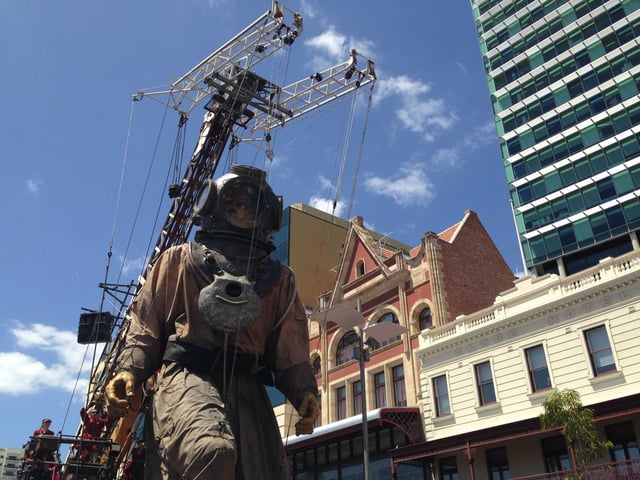
2015 Perth International Arts Festival
A number of annual events are held in Perth. The Perth International Arts Festival is a large cultural festival that has been held annually since 1953, and has since been joined by the Winter Arts festival, Perth Fringe Festival, and Perth Writers Festival. Perth also hosts annual music festivals including Listen Out, Origin and St Jerome's Laneway Festival. The Perth International Comedy Festival features a variety of local and international comedic talent, with performances held at the Astor Theatre and nearby venues in Mount Lawley, and regular night food markets throughout the summer months across Perth and its surrounding suburbs. Sculpture by the Sea showcases a range of local and international sculptors' creations along Cottesloe Beach. There is also a wide variety of public art and sculptures on display across the city, throughout the year.
Tourism and recreation
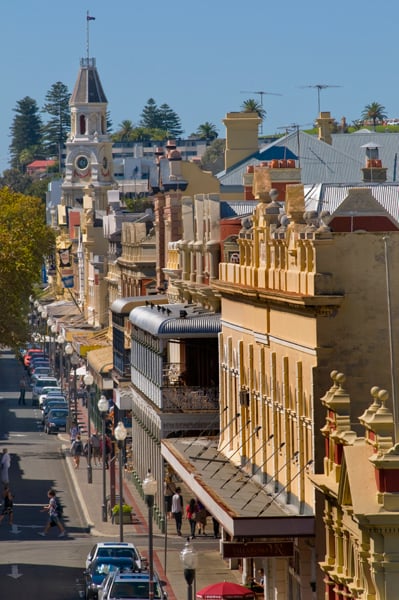
Fremantle is known for its well-preserved architectural heritage.
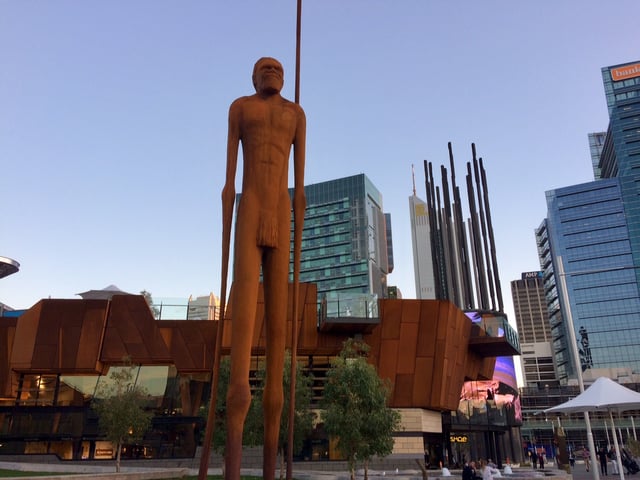
The "Wirin" sculpture at Perth's Yagan Square

Hyde Park
Tourism in Perth is an important part of the state's economy, with approximately 2.8 million domestic visitors and 0.7 million international visitors in the year ending March 2012.[147] Tourist attractions are generally focused around the city centre, Fremantle, the coast, and the Swan River. In addition to the Perth Cultural Centre, there are dozens of museums across the city. The Scitech Discovery Centre in West Perth is an interactive science museum, with regularly changing exhibitions on a large range of science and technology based subjects. Scitech also conducts live science demonstration shows, and operates the adjacent Horizon planetarium. The Western Australian Maritime Museum in Fremantle displays maritime objects from all eras. It houses Australia II, the yacht that won the 1983 America's Cup, as well as a former Royal Australian Navy submarine. Also located in Fremantle is the Army Museum of Western Australia, situated within a historic artillery barracks. The museum consists of several galleries which reflect the Army's involvement in Western Australia, and the military service of Western Australians.[148] The museum holds numerous items of significance, including three Victoria Crosses.[149] Aviation history is represented by the Aviation Heritage Museum in Bull Creek, with its significant collection of aircraft, including a Lancaster bomber and a Catalina of the type operated from the Swan River during WWII.[150] There are many heritage sites in Perth's CBD, Fremantle, and other parts of the metropolitan areas. Some of the oldest remaining buildings, dating back to the 1830s, include the Round House in Fremantle, the Old Mill in South Perth, and the Old Court House in the city centre. Registers of important buildings are maintained by the Heritage Council of Western Australia and local governments. A late heritage building is the Perth Mint.[151] Yagan Square connects Northbridge and the Perth CBD, with a 45-metre-high digital tower and the 9-metre statue "Wirin" designed by Noongar artist Tjyllyungoo. Elizabeth Quay is also a notable attraction in Perth, featuring Swan Bells and a panoramic view of Swan River.
Retail shopping in the Perth CBD is focused around Murray Street and Hay Street. Both of these streets are pedestrian malls between William Street and Barrack Street. Forrest Place is another pedestrian mall, connecting the Murray Street mall to Wellington Street and the Perth railway station. A number of arcades run between Hay Street and Murray Street, including the Piccadilly Arcade, which housed the Piccadilly Cinema until it closed in late 2013. Other shopping precincts include Harbour Town in West Perth, featuring factory outlets for major brands, the historically significant Fremantle Markets, which date back to 1897, and the Midland townsite on Great Eastern Highway, combining historic development around the Town Hall and Post Office buildings with the modern Midland Gate shopping centre further east. Joondalup's central business district is largely a shopping and retail area lined with townhouses and apartments, and also features Lakeside Joondalup Shopping City. Joondalup was granted the status of "tourism precinct" by the State Government in 2009, allowing for extended retail trading hours.
The Swan Valley, with fertile soil, uncommon in the Perth region, features numerous wineries such as the large complex at Houghtons, the state's biggest producer, Sandalfords and many smaller operators, including microbreweries and rum distilleries. The Swan Valley also contains specialised food producers, many restaurants and cafes, and roadside local-produce stalls that sell seasonal fruit throughout the year. Tourist Drive 203 is a circular route in the Swan Valley, passing by many attractions on West Swan Road and Great Northern Highway. Kings Park, located in central Perth between the CBD and the University of Western Australia, is one of the world's largest inner-city parks,[152] at 400.6 hectares (990 acres).[153] There are many landmarks and attractions within Kings Park, including the State War Memorial Precinct on Mount Eliza, Western Australian Botanic Garden, and children's playgrounds. Other features include DNA Tower, a 15 m (49 ft) high double helix staircase that resembles the deoxyribonucleic acid (DNA) molecule,[154] and Jacob's Ladder, comprising 242 steps that lead down to Mounts Bay Road. Hyde Park is another inner-city park located 2 km (1.2 mi) north of the CBD. It was gazetted as a public park in 1897, created from 15 ha (37 acres) of a chain of wetlands known as Third Swamp.[155] Avon Valley, John Forrest and Yanchep national parks are areas of protected bushland at the northern and eastern edges of the metropolitan area. Within the city's northern suburbs is Whiteman Park, a 4,000-hectare (9,900-acre) bushland area, with bushwalking trails, bike paths, sports facilities, playgrounds, a vintage tramway, a light railway on a 6-kilometre (3.7 mi) track, motor and tractor museums, and Caversham Wildlife Park.
Perth Zoo, located in South Perth, houses a variety of Australian and exotic animals from around the globe. The zoo is home to highly successful breeding programs for orangutans and giraffes, and participates in captive breeding and reintroduction efforts for a number of Western Australian species, including the numbat, the dibbler, the chuditch, and the western swamp tortoise.[156] More wildlife can be observed at the Aquarium of Western Australia in Hillarys, which is Australia's largest aquarium, specialising in marine animals that inhabit the 12,000-kilometre-long (7,500 mi) western coast of Australia. The northern Perth section of the coastline is known as Sunset Coast; it includes numerous beaches and the Marmion Marine Park, a protected area inhabited by tropical fish, Australian sea lions and bottlenose dolphins, and traversed by humpback whales. Tourist Drive 204, also known as Sunset Coast Tourist Drive, is a designated route from North Fremantle to Iluka along coastal roads.
Sport
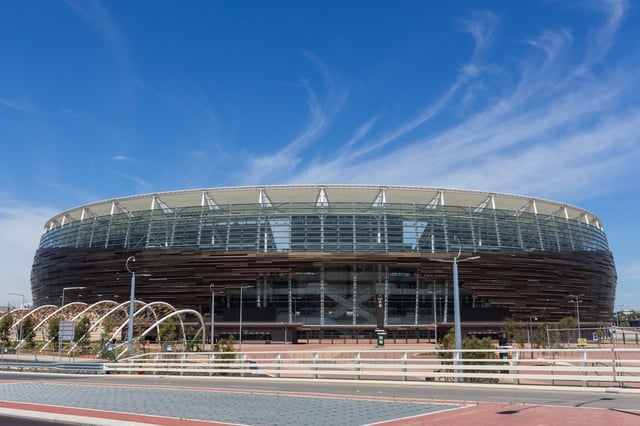
Optus Stadium hosts cricket and Australian rules football, Perth's most popular spectator sports

The exterior of Perth Arena
The climate of Perth allows for extensive outdoor sporting activity, and this is reflected in the wide variety of sports available to residents of the city. Perth was host to the 1962 Commonwealth Games and the 1987 America's Cup defence (based at Fremantle). Australian rules football is the most popular spectator sport in Perth – nearly 23% of Western Australians attended a match at least once in 2009–2010.[157] The two Australian Football League teams located in Perth, the West Coast Eagles and the Fremantle Football Club, have two of the largest fan bases in the country. The Eagles, the older club, is one of the most successful teams in the league, and one of the largest sporting clubs in Australia.The next level of football is the Western Australian Football League, comprising nine clubs each having a League, Reserves and Colts team. Each of these clubs has a junior football system for ages 7 to 17. The next level of Australian rules football is the Western Australian Amateur Football League, comprising 68 clubs servicing senior footballers within the metropolitan area. Other popular sports include cricket, basketball, soccer, and rugby union.[158]
| Club | League | Sport | Venue | Established |
|---|---|---|---|---|
| Fremantle Dockers | AFL/AFL Women's | Australian rules football | Optus Stadium | 1994 |
| West Coast Eagles | Australian Football League | Australian rules football | Optus Stadium | 1986 |
| Perth Wildcats | National Basketball League | Basketball | Perth Arena | 1982 |
| Perth Lynx | Women's NBL | Basketball | Bendat Basketball Centre | 1988 |
| Perth Glory FC | A-League | Soccer | HBF Park | 1996 |
| Perth Glory FC W-League | W-League | Soccer | Ashfield Reserve | 2008 |
| Western Force | Global Rapid Rugby | Rugby union | HBF Park | 2005 |
| Western Force | National Rugby Championship | Rugby union | UWA Sports Park | 2007 |
| RugbyWA | Super W | Rugby union | Harvey Field Kingsway Reserve | 2018 |
| Perth Heat | Australian Baseball League | Baseball | Harley-Davidson Ballpark | 1989 |
| West Coast Fever | ANZ Championship | Netball | RAC Arena Perth Arena | 1997 |
| West Coast Pirates | S.G. Ball Cup | Rugby league | HBF Park | 2012 |
| Western Warriors | Sheffield Shield | Cricket | WACA Ground | 1893 |
| Perth Scorchers | Big Bash/Women's Big Bash | Cricket | Optus Stadium | 2011 |
| Western Fury | Women's National Cricket League | Cricket | WACA Ground | 1996 |
| Perth Thunder | Australian Ice Hockey League | Ice Hockey | Perth Ice Arena | 2010 |
Perth has hosted numerous state and international sporting events. Ongoing international events include the Hopman Cup during the first week of January at the Perth Arena, and the Perth International golf tournament at Lake Karrinyup Country Club. In addition to these Perth has hosted the Rally Australia of the World Rally Championships from 1989 to 2006, international Rugby Union games, including qualifying matches for 2003 Rugby World Cup. The 1991 and 1998 FINA World Championships were held in Perth.[159] Four races (2006, 2007, 2008 and 2010) in the Red Bull Air Race World Championship have been held on a stretch of the Swan River called Perth Water, using Langley Park as a temporary air field.[160] Several motorsport facilities exist in Perth including Perth Motorplex, catering to drag racing and speedway, and Barbagallo Raceway for circuit racing and drifting, which hosts a V8 Supercars round. Perth also has two thoroughbred racing facilities: Ascot, home of the Railway Stakes and Perth Cup; and Belmont Park.
The WACA Ground opened in the 1890s and has hosted Test cricket since 1970. The Western Australian Athletics Stadium opened in 2009.
Infrastructure
Health
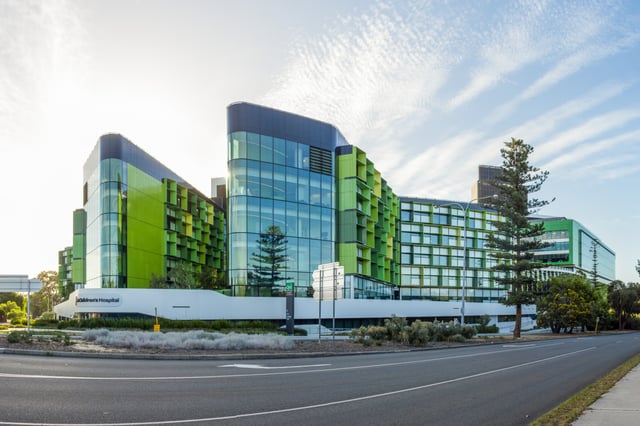
Perth Children's Hospital
Perth has ten large hospitals with emergency departments. As of 2013, Royal Perth Hospital in the city centre is the largest, with others spread around the metropolitan area: Armadale Kelmscott District Memorial Hospital, Joondalup Health Campus, King Edward Memorial Hospital for Women in Subiaco, Rockingham General Hospital, Sir Charles Gairdner Hospital in Nedlands, St John of God Murdoch and Subiaco Hospitals, Midland Health Campus in Midland, and Fiona Stanley Hospital in Murdoch. Perth Children's Hospital is the state's only specialist children's hospital, and Graylands Hospital is the only public stand-alone psychiatric teaching hospital. Most of these are public hospitals, with some operating under public-private partnerships. St John of God Murdoch and Subiaco Hospitals, and Hollywood Hospital are large privately owned and operated hospitals.
A number of other public and private hospitals operate in Perth.[161]
Transport
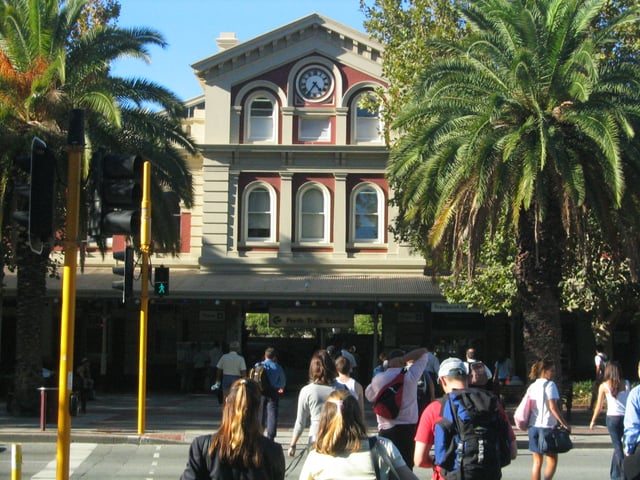
Wellington Street entrance to Perth railway station
Perth is served by Perth Airport in the city's east for regional, domestic and international flights and Jandakot Airport in the city's southern suburbs for general aviation and charter flights.
Perth has a road network with three freeways and nine metropolitan highways. The Northbridge tunnel, part of the Graham Farmer Freeway, is the only significant road tunnel in Perth.
Perth metropolitan public transport, including trains, buses and ferries, are provided by Transperth, with links to rural areas provided by Transwa. There are 70 railway stations and 15 bus stations in the metropolitan area.
Perth provides zero-fare bus and train trips around the city centre (the "Free Transit Zone"), including four high-frequency CAT bus routes.
The Indian Pacific passenger rail service connects Perth with Adelaide and Sydney once per week in each direction. The Prospector passenger rail service connects Perth with Kalgoorlie via several Wheatbelt towns, while the Australind connects to Bunbury, and the AvonLink connects to Northam.
Rail freight terminates at the Kewdale Rail Terminal, 15 km (9 mi) south-east of the city centre.
Utilities
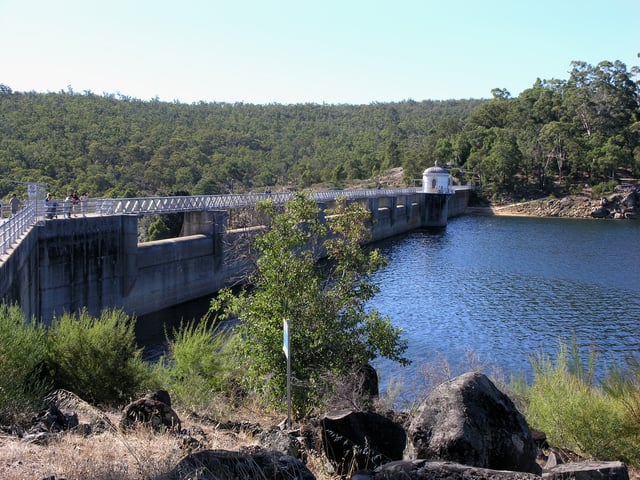
Mundaring Weir
Perth's electricity is predominantly generated, supplied, and retailed by three Western Australian Government corporations. Verve Energy operates coal and gas power generation stations, as well as wind farms and other power sources.[164] The physical network is maintained by Western Power,[165] while Synergy, the state's largest energy retailer, sells electricity to residential and business customers.[166]
Alinta Energy, which was previously a government owned company, had a monopoly in the domestic gas market since the 1990s. However, in 2013 Kleenheat Gas began operating in the market, allowing consumers to choose their gas retailer.[167]
The Water Corporation is the dominant supplier of water, as well as wastewater and drainage services, in Perth and throughout Western Australia. It is also owned by the state government.[168]
Perth's water supply has traditionally relied on both groundwater and rain-fed dams. Reduced rainfall in the region over recent decades had greatly lowered inflow to reservoirs and affected groundwater levels. Coupled with the city's relatively high growth rate, this led to concerns that Perth could run out of water in the near future.[169] The Western Australian Government responded by building desalination plants, and introducing mandatory household sprinkler restrictions. The Kwinana Desalination Plant was opened in 2006,[170][171] and Southern Seawater Desalination Plant at Binningup (on the coast between Mandurah and Bunbury) began operating in 2011. A trial winter (1 June – 31 August) sprinkler ban was introduced in 2009 by the State Government, a move which the Government later announced would be made permanent.[172]
See also
List of islands of Perth, Western Australia
List of Perth suburbs
